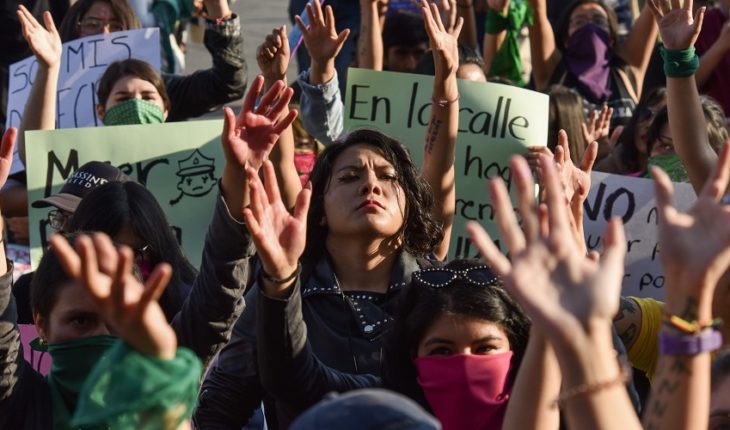For the first time, a gender alert for the disappearance of women was decreed in Mexico, in seven municipalities of the State of Mexico, although it is the second call for that entity, after the 2015 one, so activists and family members who promoted this measure consider that the actions taken in the past have not been effective.
As evidence, the NGO I(dh)eas Strategic Litigation in Human Rights revealed data obtained through transparency of the low level of investigation and punishment there is: only 1 of the 4,425 cases of investigation and punishment are being investigated as enforced disappearance committed by individuals registered between August 2014 and December 2018 (of which about half are women), according to information from the Office of the Attorney General.
In addition, as of June 10, 2019, only 11 research folders involving 13 victims, nine of whom are women, have been prosecuted. Six arrest warrants have been issued against 14 likely persons responsible for disappearance covering six women and one man. And only four people are linked to prosecution for five disappearances, all of them of women – including a two-month-old baby who disappears with a 28-year-old woman.
Read more: Declare Second Gender Violence Alert in Edomex, for the Disappearance of Women and Girls
I(dh)eas and the Mexican Institute of Human Rights and Democracy (IMDHD) stated this October 3, a day after the alert was declared, that for results to be very specific actions, such as linking the information of disappearances with other crimes such as human trafficking, or investing in the technology used to investigate and, above all, an achievement assessment.
Edomex’s Secretary of Justice and Human Rights Rodrigo Espeleta acknowledged in an interview that one of the missing things is human resources and budgetary capacity, but that with this new alert you are in time to ask the local Congress for enough money . He said that since 2015 there were advances, such as a better legal framework and specialized units in the search for people, although factors such as the masculinity that generates violence and the training of officials to address the issue are lacking.
“It is a multifactorial problem, which we have taken care of since the first alert, but what this second alert does is put the points on the íes of where we have to strengthen to specifically address the phenomenon of disappearance,” he said.
Here are some of the specific actions that activists believe should be implemented:
– To draw a link between crimes, since until now, they have denounced, the relationship of disappearances with human trafficking and femicide has been ignored. Ximena Ugarte, IMDHD’s attorney, criticized that four years after the first gender alert there are still no reliable records of the disappearance of women, as the figures of the National Register of Missing Persons do not match those granted by the State Prosecutor’s Office, and there is no sequence of violence since it starts at home or there is an attack in the public space to how it ends in a femicide, in many cases, and therefore the patterns of crime have not been found.
“Women, before they were killed, were disappeared, but they don’t seem to exist. Just as in the case of some girls who were raped, they were previously disappeared,” stressed Elsa Arista, of Nos Que Vivas Neza.
-Improve the technological resources of the authorities investigating the cases, as they have detected that sensitive information is shared by phone chats.
“That at least they have walkie talkies closed circuit slam that allow the assurance of information. That is, super sensitive data is being transferred from where the person may be, where it was the last time they saw it, what the geolocation data of the last call is, and that’s what they’re having through WhatsApp! We are facing criminal networks, and sometimes the state itself, at certain levels,” Ugarte said.
-Improving the training of officials, not only in general on issues of gender-based violence , and where trainers are often male, according to Ugarte, but improving the capacities of those who may specifically be involved with research.
You may be interested: Amparo forces CDMX to decree gender alert; violence is from the previous regime, Says Sheinbaum
-Review and reclassify crimes of the last five years, since it was not previously criminalized disappearance. Veronica Berber, lawyer at I(dh)eas, explained that many cases are filed or only as circumstantial minutes of women who were reported as unlocalized. Now, that you already have legislation that criminalizes the enforced disappearance or disappearance committed by individuals, and there are municipal search cells, specialized prosecutor’s office in search of missing persons and Local Search Commission, you could take the cases to immediately initiate investigations, which favor the idea of lifelong search.
-Strengthen units of context analysis, create research plans for each case and that the disappearances are actually investigated, since families report that no action is being taken. Laura Curiel, founder of the collective Alondras and mom of Daniela Mabel Sanchez, who disappeared in 2015, asked for working tables immediately for the authorities to integrate families into the investigation and keep them informed, as they do not see advances in their cases. And he demanded that it be the state who is on the street looking for the missing, and not them as mothers.
-That the experience of the State be replicable in other entities, since a corridor of violence against women has been detected in Veracruz, with the highest rates of femicide; Puebla, of disappearances; Tlaxcala, trafficking women; and now Mexico City with alert for attacks on transportation and public spaces.
-Generate information not only quantitative (how many specialized units or personnel there are) but qualitative, that is, have evaluations of how it is actually working. Berber explained that there has been widespread criticism of the gender alert figure that it has not worked, as if it were the fault of the NGOs proposing it, when in fact the state has failed. So this time, he said, it is important to establish performance indicators, as one of the mandates of the alert is to develop a scheduled work program.
The alert itself stipulates that in six months the National Commission to Prevent and Eradicate Violence against Women (Conavim) should be informed of the actions taken to prevent the disappearance of women in the State of Mexico.
With information from Eréndira Aquino
What we do in Animal Político requires professional journalists, teamwork, dialogue with readers and something very important: independence. You can help us keep going. Be part of the team.
Subscribe to Animal Politician, receive benefits and support free journalism.#YoSoyAnimal
translated from Spanish: How to prevent the disappearance of women in Edomex?
October 6, 2019 |





